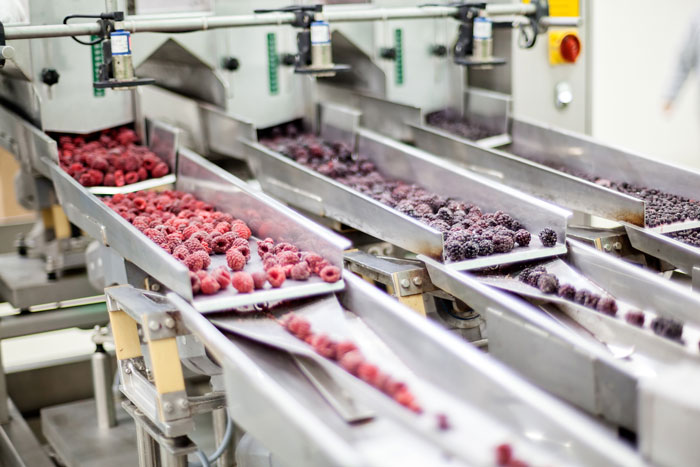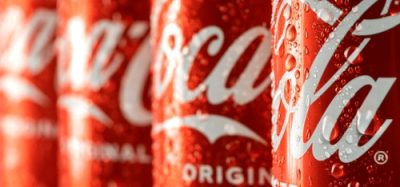Seven misconceptions about food-grade lubricants
- Like
- Digg
- Del
- Tumblr
- VKontakte
- Buffer
- Love This
- Odnoklassniki
- Meneame
- Blogger
- Amazon
- Yahoo Mail
- Gmail
- AOL
- Newsvine
- HackerNews
- Evernote
- MySpace
- Mail.ru
- Viadeo
- Line
- Comments
- Yummly
- SMS
- Viber
- Telegram
- Subscribe
- Skype
- Facebook Messenger
- Kakao
- LiveJournal
- Yammer
- Edgar
- Fintel
- Mix
- Instapaper
- Copy Link
Posted: 14 May 2021 | Orsi Dézsi | No comments yet
Orsi Dészi, Business Unit Manager–Nonfood Compounds, NSF International, debunks some common myths around food-grade lubricants.


According to a Research and Markets report, the food processing market is projected to reach around USD$4.1 trillion by 2024.1 This outlook is based on a growing demand for ready-to-eat food products, changing lifestyles, and a rising number of nuclear families and working women. In addition to meeting increased consumer demand, food and beverage processors must also negotiate with heightened expectations for food safety. Using food-grade lubricants (FGLs) is one way to satisfy both requirements.
FGLs are incidental food contact lubricants and greases that keep processing equipment operating and also address concerns about chemical hazards. Some food and beverage companies, however, doubt the products’ ability to meet their production needs, despite any strong evidence for this. There remains to be misconceptions surrounding FGLs, which shall be addressed here.
Before going any further, it would be best to establish what is meant by ‘food grade’ from a regulatory point of view. FGLs are registered under the H1 category of lubricants or certified to ISO 21469, Safety of Machinery, Lubricants with Incidental Product Contact-Hygiene Requirements. The difference between H1 and ISO 21469 is explained later in this article.
Misconception #1
FGLs are edible
Perhaps this myth conjures up images of cooking oils, which may lead to the idea that FGLs are somehow a lesser product in terms of industrial performance. The term ‘food grade’ is not in reference to edibility but rather food safety. When lubricants are used in a food or beverage processing facility, the goal is always zero contact. The reason for using FGLs is to avoid serious problems in the event of minor contact with the food, known as ‘incidental contact’. There is a 10 parts-per-million (ppm) limit for lubricant base oils that can be present if such contact occurs. If the amount is greater than 10ppm, then those food products that have been compromised should be discarded.
Misconception #2
FGLs do not perform as well as industrial-grade lubricants
The first generation of FGLs had a difficult time contending with tougher operating conditions and offered minimal equipment protection. The performance disparity between food-grade and industrial‑grade was vast…this was also about 60 years ago. Since then, FGLs have come a long way in terms of meeting tougher production demands, while contributing to better wear protection, greater production efficiency and longer equipment life.
Today’s FGLs can stand up to corrosion, friction, extreme temperatures, oxidation, heavy washdowns, and harsh conditions just as well as their industrial-grade counterparts. There are now new base oils, additives and thickeners available to lubricant manufacturers that have closed the performance gap. In addition, a better understanding of lubricant chemistry has enabled formulators to create products with stronger, more stable molecular structures.
Misconception #3
Lubricants containing MOSH and MOAH are health risks
There is no dispute that mineral oil saturated hydrocarbons (MOSH) and mineral oil aromatic hydrocarbons (MOAH) are present in the mineral oils used as base oils for FGLs; however, to say they cause human health issues is unfounded. There is currently no toxicological evidence that can scientifically conclude MOSH have adverse effects on human health. Furthermore, when mineral oils are refined for FGLs, the MOAH that might be considered as potentially hazardous (ie, those consisting of three or more polycyclic aromatic compounds) are removed, leaving at most trace amounts of MOAH in the final product.


A lubricant should be manufactured the way it is registered, and the amount used on a piece of equipment should be the minimum required to accomplish the required technical effect. If both measures are met, a food or beverage processor can assume the product is not a health risk due to MOSH or MOAH.
What adds to the complexity of the MOSH and MOAH discussion is the inability to determine precisely where these substances come from when detected in food. Points of origin could include packaging materials, exhaust gases from the environment, lubricants, or food additives such as separating, coating and glazing agents. Since MOSH and MOAH are not traceable to any definitive source, they have not led to any regulatory restrictions around the use of FGLs.
Misconception #4
Lubricant requirements are biased toward American regulations
If this were true, why would international GFSI certification programme owners like BRCGS, IFS and SQF reference or even require the use of FGLs? The term ‘food-grade’ has no nationality. Many international regulatory agencies have simply adopted the US Food and Drug Administration (FDA) Code of Federal Regulations Title 21 Section 178.3570 (21 CFR 178.3570) in determining what they consider to be FGLs.
Another misunderstanding is that registration programmes operate under the US Department of Agriculture (USDA). In 1998, the USDA discontinued its review and listing programme for propriety substances and nonfood compounds used in food processing facilities The USDA shifted this responsibility of evaluating chemical compounds to an independent, public health organisation called NSF International. Since then, NSF has become a globally recognised registration body and leading authority on lubricants used in food processing and handling facilities.
Misconception #5
FGL options are limited
There are currently more than 12,000 H1‑registered lubricants designed for different applications, equipment types and machine components. For example, there are FGLs that can perform in temperature conditions as low as -46°C and as high as 163°C. Others can also protect processing equipment against extremely heavy production loads. There are even FGLs that are fire resistant or have anti-microbial properties.
This breadth of products is due in part to the fact that the ingredients ceiling does not end at 21 CFR 178.3570. Substances with a generally recognised as safe (GRAS) status are also considered acceptable. In addition, formulators are constantly innovating and investing in chemical technologies outside the traditional realm of 21 CFR. A lubricant manufacturer or ingredients supplier can submit a food contact notification (FCN) to the FDA for currently unregulated food contact substances. Once approved by the FDA, the ingredient can then be used. As an alternative to FCNs, a lubricant manufacturer can also apply for a threshold of regulation (TOR) exception from the FDA.
Misconception #6
If you use FGLs anywhere, you have to use them everywhere
Food-grade and industrial-grade lubricants are not mixable with one another; however, this does not mean they cannot be used separately at the same food or beverage processing facility.
Any processing area ‘above the production line’ should only use FGLs. These are the parts of a facility that involve activities such as canning, blending, slicing, cutting or handling. In contrast, there can be no contact whatsoever between industrial-grade lubricants and food. Industrial-grade products are to be used exclusively ‘below the line’ within closed equipment systems and in areas where contact with food is not possible. If there is any doubt about what type of lubricant is appropriate, defer to the food‑grade option.
To help eliminate the risk of cross contamination, read product labels carefully before each use. Industrial‑grade products are registered under the H2 category of lubricants. This means H2‑labelled products must never be mixed with H1- or ISO 21469-labelled products.
Misconception #7
‘Food grade’ means it is also allergen-free, kosher and/or halal
While ingredients-based, the criteria for being food-grade are not dietary. The intent is to determine if incidental contact with food is allowed. H1 registration and ISO 21469 certification requirements dictate that lubricants must meet regulatory guidelines and cannot contain carcinogens, mutagens, teratogens, mineral acids, or intentionally added heavy metals. They do not account for allergens, nor do they verify if the lubricant is manufactured according to kosher and halal requirements. ‘Food grade’ is not meant to suggest a product is a food ingredient. That is why allergen-free, kosher and halal designations are officially handled by separate certification schemes.
The difference between H1-registered and ISO 21469-certified lubricants
For the most part, either is accepted worldwide by regulators and auditors as food-grade products; however, H1‑registered lubricants are meant only for food and beverage processing facilities. Lubricants certified to ISO 21469 are also accepted by the pharmaceutical, cosmetics, tobacco and animal feed industries.
Both H1 and ISO 21469 have labelling requirements and 21 CFR-based formulation requirements. ISO 21469, however, goes further by including risk assessments, testing and production facility audits as part of its certification process. It is the lone global standard for lubricants. In addition, ISO 21469 certifications are also required for products exported from or imported to Brazil.
The decision to use H1-registered or ISO 21469-certified lubricants (outside of Brazil) is based on a food or beverage company’s own benchmarks for food safety.
Conclusion
What a FGL is and is not are equally important; they are not edible but do allow for incidental contact with food. At the same time, a FGL is a high‑performance product that can help food and beverage processors on their path to GFSI certifications. H1-registered or ISO 21469-certified lubricants are not limited in their varieties and, when used as intended, they are not a health risk. Use of a FGL enables food and beverage companies to achieve a balance between production demands and food safety.
Orsi Dézsi
Orsi is the Global Program Lead at NSF International for the Food Safety-Product Certification Group, which includes the nonfood compounds and food contact material compliance programme. For the past 15 years, Orsi has worked closely with the regulatory community, industry stakeholders and clients to navigate the evolving global regulatory landscape in both food equipment design and material regulations. Orsi’s passion for NSF’s mission of protecting and improving human health is what drives her to help clients find straightforward solutions in a complex regulatory environment.
Reference
1. www.researchandmarkets.com/reports/4832757/food-processing-market-report-trends-forecast
Issue
Related topics
Related organisations
NSF International, The US Food and Drug Administration (FDA)







